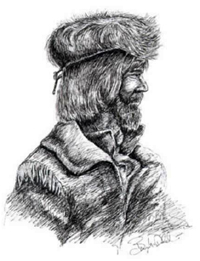
Hiram Scott
The answer to that question is shrouded in mystery and has intrigued travelers through the North Platte river valley for almost two centuries.
We do know that there was a man by the name of Hiram Scott who was employed by the American Fur Company. His name appears on the pay lists of that company in 1827, where he is listed as a clerk. We also know that his name does not appear in any of the company's papers after 1828.
Beyond this - little else is known with any certainty. In the early days of the fur trade, it was the practice of the various fur comapnies to send trappers into the Far West to gather pelts which would then be brought back to St. Louis and sold to eastern buyers.
In exchange for the furs, the companies would offer manufactured items such as pots and pans, bolts of cloth, knives, axes, and firearms.
Each spring caravans of traders ventured into the frontier loaded with trade goods. They would meet with the tribesmen and independent fur trappers at pre-arranged sites to conduct their business. Each of these annual events came to be known as a fur trading "rendezvous."
Clerks such as Hiram Scott were necessary to keep track of the many transactions which were made at a rendezvous. Many different accounts had to be maintained, payrolls met and accurate inventories of the trade goods had to be kept. The responsibilities of a fur company clerk would have required a reliable, well-organized, and above all - a literate person.
It is believed that Hiram Scott was returning to St. Louis from the 1828 rendezvous when he died near the bluff which now bears his name. Unfortunately, the details surrounding his death have been lost to history.
A subtle variation on this story was recorded two years later by Washington Irving. Instead of being abandoned by just two men, the ailing Scott was supposedly left behind at the Laramie Fork by a larger party who feared for their lives due to starvation. The next summer, Scott's bones were found near the bluffs - 60 miles from where he had been left to die.
In 1834, missionary Jason Lee recorded a story about Hirman Scott that was very similar to those earlier versions, except that the pathetic Scott had traversed 100 miles before dying near the bluffs on the North Platte River.
There has been some speculation that Hiram Scott was actually injured in an encounter with some Blackfeet Indians that took place at the 1828 rendezvous at Bear Lake, Utah. This has been used to explain why Scott became incapacitated on his journey back east, but as with most of the information about Hirman Scott, very little is known for certain.
The fur trade continued for a decade after Hiram Scott's death in 1828, but by 1840, the beaver had been trapped out and fashions changed. When men began wearing hats made of silk instead of beaver fur, the value of furs dropped. Twenty years later a demand for buffalo hides briefly rekindled fur trading on the high plains.
Hiram Scott's final resting place is not known. His remains were almost certainly found near the North Platte River, but the site has never been located. Today, a plaque dedicated to his memory is located along the North Overlook Trail on the summit of the bluff that bears his name.
Over the years, the geological features known as "Scotts Bluff's" have taken on their own individual names. They are now known as Dome Rock, Crown Rock, Sentinel Rock, Eagle Rock, and Saddle Rock. However, the largest and most prominent is known as Scotts Bluff, and still stands as a landmark for travelers and a reminder of the tragic incident that took place nearly two centuries ago.